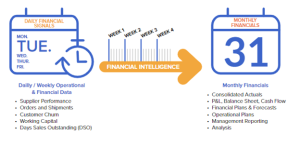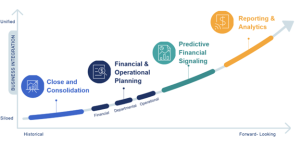This article first appeared on OneStreamsoftware.com by Whitney Gillespie
Most Finance professionals are likely familiar with falling victim to bad analytics, especially the feeling that comes with having all the information needed to predict future market conditions, but being held back by the EPM technology. While the thought of advanced analytics often conjures sci-fi images of robots and flying cars, such analytics are more of a reality than a pipe dream. Leveraging quality operational analytics and unleashing the goldmine of data Finance is sitting on doesn’t require an advance computer science degree either. Rather, enabling useful insights with the proper technical enablers is key to driving financial results proactively instead of reactively.
In my previous role as a financial analyst, I was always frustrated by the wealth of unused data at my fingertips, be it that the data was inaccessible or just too large a dataset for one person to sift through. The “A” part of “FP&A” often felt like the biggest challenge in the role. Instead of being analytical, I was often faced with looking backward wondering why I couldn’t anticipate events that the data should have alerted on well before month-end.
But the main thing holding me back from truly being predictive wasn’t lack of access to data or a limited data set. The culprit was the time and technology available to do the analysis. In essence, I was spending more time as a glorified data wrangler and spreadsheet jockey than as a true analyst. I may have become a professional Excel® formula writer, but a huge missing piece prevented me from truly being proactive in my job.
Unleash the Power of Finance by Leveraging Financial Signaling to Drive Operational Analytics
Leveraging operational analytics and financial signaling in my financial analysis role would have truly been key to flipping a reactive role into a proactive one – ultimately elevating my role to valued business partner. But how?
Well, to start, financial signaling (Figure 1) is the process through which Finance teams can finally harness the vast amounts of daily and weekly transactional and operational data from across the organization. By deciphering the hidden signals with large volumes of data, FP&A teams can help guide organizational leadership to act midstream and impact the financials – all before month-end.

Figure 1: Using financial signaling enables quicker and more reliable decision-making based on data
What does financial signaling have to do with advanced or operational analytics? Well, some sort of tool is needed to analyze and visualize what financial signaling is revealing through regular data updates. Financial signaling enables users to intake data on a regular basis, but the advanced analytic framework must be in place to make sense of the data and publish it in a way that can be shared with leadership and other decision-makers. Thus, using financial signaling allows for quicker and more informed decisions (Figure 2) that help an organization proactively drive financial results instead of looking backward at month-end wondering why things turned out the way they did.

Figure 2: Financial signaling enables effective reporting and analytics by being a forward-looking process
Examples of Financial Signaling Driven Advanced Analytics
While financial signaling clearly benefits the Office of Finance, some real-life use cases for this functionality offer even more insight. Here are just a few options for leveraging this functionality:
- Corporate Finance: Financial signaling allows for generating and tracking performance against budget and forecast data, AOP, strategic plans and long-range plans. Predictive capabilities can also be used to spot potential disruption before it strikes and capitalize on opportunities.
- Operational Finance: Financial signaling allows Finance to partner with Sales & Operations Planning (S&OP) partners and processes to generate, track performance against, and update the sales and operations plans that drive the supply chain and operations planning for the year.
- Divisional Finance: Financial signaling allows for tracking daily, weekly and monthly metrics relevant to the business while staying in step with corporate financial metrics and goals. Finance can also track goals against strategic initiatives and the sales–product mix.
Conclusion
Finance must remain agile and adaptable in the face of increasing market disruption and increasingly faster business speeds. To do so, Finance must deploy and utilize operational analytics in a way that allows for better, faster and more accurate forecasting. To answer the question of how to proactively drive performance ahead of month-end, Finance can leverage financial signaling for faster and more frequent data analysis to make sense of and publish the data in a format that can be quickly and effectively shared with leadership. That functionality is the key to driving strategic financial goals and ultimately maintaining Finance’s partnership with key stakeholders within the business.
Learn More
Want to learn more about leveraging financial signaling and advanced analytics to elevate your financial processes? Check out our eBook on Advanced Analytics to help your Finance team lead at speed.




